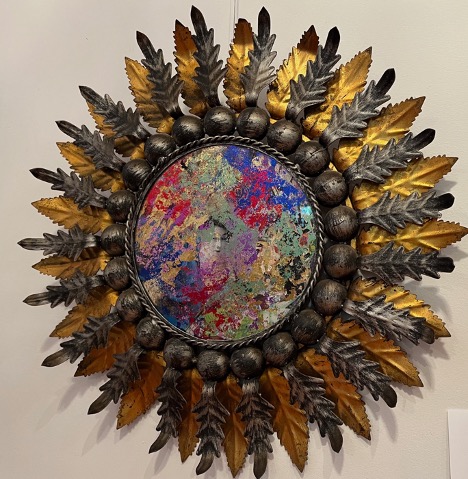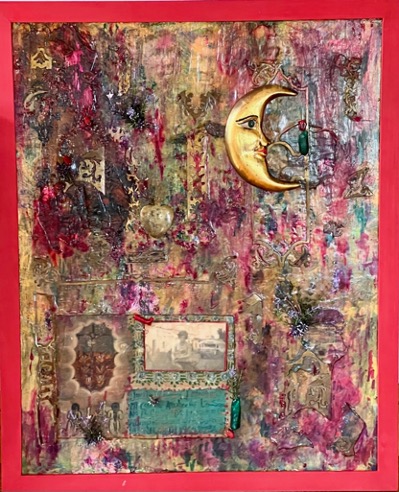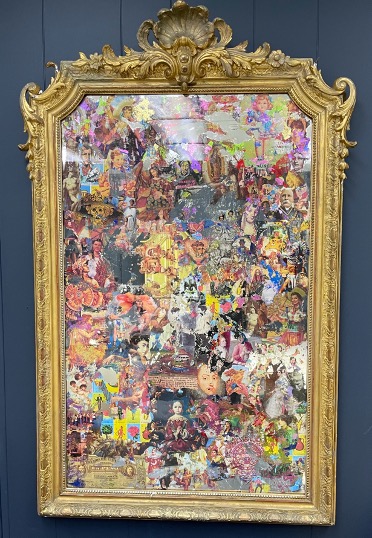Carlos Alberto Vega’s mirror art draws in the viewer for a closer examination as they hold glimpses of their own reflection amidst the vibrant and colorful symbols and icons imprinted on vintage, mixed-media mirrors.
“Some say that a mirror merely reflects, only bouncing back what is cast upon it–albeit in reverse. But what if a mirror has memory? What if the images are not only reflected but also retained–even if only as scattered images and moments, much as we remember our own past?” says the Chicano artist, about his mirror art which captures the “hybridity” of his own culture and spirit across his beloved Latinx community, “shaped and reshaped by places left behind and those to be found.”

Feathered Wisps by Carlos Vega
Raised on the Mexico-U.S. border, Vega’s life now oscillates between New England and the South of Spain with frequent visits to the heart of Mexico. His formal training and education include studies in Paris, New York, and Boston. As a professor of Medieval Literature at Wellesley College, he understands the fascination and magnitude of mirrors in Medieval European Art as well as the mirrors of the Renaissance era. He is inspired by the closely familiar rich European civilization that is essential to his work. A braided dialogue of Europe’s golden years of creativity and artistic expression is fused in the transformative way his mirror art transgresses the old and the new and leans on the abundance of Baroque art with a refined modernity that allows the viewer to rethink the universal and essential questions of the past and the future. Who we are when we gaze at a mirror? Do we recognize the past or the future of the past?
Vega’s academic focus on literature, culture, and hagiography (the study of the lives of saints), led him to initiate the study of hagiographic motifs in an American/Hispanic context, examining the role of religious cultural icons (products of both European Catholic and Native American traditions) in a political and aesthetic agenda.
Elevating the Mexican folk art of painted mirrors to the next level of surface infiltration, Vega’s vintage mirrors, enveloped in antique frames are ladened with their own visual stories. Working on partially distressed mirrors, he further erodes the reflective surface to unveil what the glass retained as a witness of the distant past–while layering personal and cultural symbols within the work. Atop existing images are encrusted gold and metal foil, paint, ink, and powdered pigment–often using a syringe, he breaks through, forming layered impressions.
In an interplay of hide-and-seek, Vega veils parts of the mirrors, making the viewer “part of the murmurings of the mirror–a component in an ever-changing surface.” Masterfully manipulating the surface of his vintage mirrors to exhume the past in a collage, he allows the viewer to see themselves in “movement or stillness” and ponder on the “evolving context of what has been shaped by a mirror with a memory.”

Baroque Rust by Carlos Vega
Yet the mirror and the viewer, “remain distinct” he says.
Vega’s mirror art examines the exteriority and interiority of existence and meaning much the same way Diego Velazquez or Leonardo Da Vinci crossed thresholds and explored both the shadows and the iridescent of the creative act. Continuing with this tradition, Vega goes further, etching the mirrors with colorful paintings and intuiting a festive mood–a fiesta of colors–while at the same time, the mirrors dwell in shadows and in the opaque. There is a radiant playfulness in Vega’s work where illusions and playfulness inhabit the work and where the viewer is invited to engage in imaginary possibilities and in the realms of absence and presence, light and shadows. Yet these mirrors are the portals of the mysterious light we carry with resilience and frailty.
At the center of Vega’s mixed-media mirror paintings–as well as his extravagant Milagro-festooned “brooches”–are undeniable religious and spiritual motifs. He assumes religion, in all its “manifestations and transgressions,” to be as “much an image, ritual, and the material, as abstract belief.”

Twin Hearts and Eyes by Carlos Vega
Expanding beyond his mirror art, Vega’s playful, ornate collection of ex-voto rhinestone brooches offers another view of centuries-old symbolism of Milagros confirming faith while “making a deal.” He adds to existing tin-etched heart–clear and colorful rhinestones juxtaposed with Milagros, plastic flowers (no watering needed), finger puppets of monsters, dinosaur heads, and googly eyes–that reflect devotional art symbols and transform them into “fantasy emulates.”
Rhinestone skulls are a repeated theme across Vega’s brooch art–dangling, glued, popping–celebrating life and the afterlife’s miracles, seeking guidance and protection from the saints and spirits, of those here, and those who have crossed over.
Vega’s History of Mexico mirror art is a pictorial tribute– both reverent and kitsch– to his ancestral homeland. Layered symbols of leading figures in the “tragedies that have marked Mexican history–a lot of which was informed by U.S. and European policies” are juxtaposed with icons of popular culture.
- Photo Room by Carlos Vega
- Photo Room by Carlos Vega
“As artists, we are only conduits to some strange forces that simply seem to take over within us and make us say or do what we express. Perhaps one thing that has come more to mind is how many layers of my culture are reflected in my works. I have come to realize more and more that I am merely a ‘channel’ that no piece of art belongs to (or is the creation of) any single person,” says Vega.
The painted mirrors of Carlos Vega have a haunting quality that remains with the viewer– whispering and illuminating from within. We remain in awe of this ancient tradition now rendered in its full modernity and magnificence.
_________________________
Author’s Bio
Marjorie Agosin is a Chilean-American poet with over 60 books, an award-winning human rights activist, a literary critic, and the Andrew W. Mellon Professor in the Humanities and Spanish at Wellesley College. Jackie Abramian is a writer and corporate communications strategist, who along with her husband owns Haley Art Gallery in Kittery, Maine.
Carlos Vega is represented by Haley Art Gallery. For purchases or to arrange exhibits of Vega’s works contact: haleygallery@comcast.net or 617-584-2580








NO COMMENT